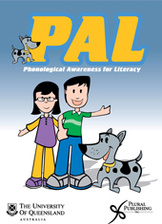Publication

Phonological Awareness for Literacy (PAL)
- Details:
- Illustrated (B/W), Spiral Bound, 8.5 x 11"
- ISBN13:
- 978-1-59756-159-4
- Release Date:
- 01/01/2009
Overview
An evidenced-based, multidisciplinary, multisensory approach to the remediation of literacy problems, this new edition includes complete instructions and scripts for all group and individual activities, as well as worksheets and record/monitor sheets. Aimed at students aged 7.5 to 13 years, it is a finely graduated program that builds phonological processing skills from basic to the complex levels required for literacy. As students gain proficiency at each level of phonological ability, the program then provides corollary instruction and overpractice in word attack strategies for reading and spelling. Non-words and real words are provided for practitioners to apply the program flexibly according to the students real word reading ability. Once full alphabetic reading at the single syllable stage is established, metacognitive strategies to deal with irregular words are taught. Finally multisyllabic word reading/spelling and reading/spelling connected text are addressed.
Frequently Asked Questions:
How many students in a group? We recommend a maximum of four students per group. This ensures you are able to provide sufficient and effective feedback to students.
How long does the program take? This depends on the students skill level. The minimum frequency recommended is one group and one individual session per week. You should allow: 45 mins to 1 hour for each group session 30 mins to 1 hour for each individual session
When do I move onto the next session? Individual Record Sheets are provided to monitor students at each level. For phonological awareness, reading and spelling activities, students need to be achieving at 80% or greater success rate before taking on new material. If students do not meet these criteria within one sitting, it is suggested that the session be repeated with supplementary activities and feedback (which are supplied in the Resource Manual at the end of the program).
Can the PAL be used with individuals? Yes! We suggest that the facilitator start with the group activities for a particular session as these introduce key concepts and strategies. The facilitator should have the individual record sheet available to record progress in the core tasks of Sound Swaps, Spelling, Reading, and Speedy Sounds.
Reviews
Margaret Costello:
"For me, and our son, the PAL program was a turning-point it was the answer that we had been seeking for many years. We had looked for help, but nothing we encountered previously helped like the PAL program. It was the critical catalyst that got him, and us, over a bridge where he was able to find new confidence in his ability to learn and read. Not only the content, but the style and philosophy that was an integral part of the programs delivery values like respect for the child, making him a partner in learning, rather than a patient, and encouragement for the child and the family these were the things that really made a difference. Since that time, my son has thrived and been able to achieve high grades. My message to parents is never be deterred from finding the help you need we found it in the PAL program developed by the University of Queensland, School of Health and Rehabilitation Sciences and for this we are eternally grateful."Angelique Kotsopoulou, Patras, Greece, Folia Phoniatrica et Logopaedica:
"I highly recommend this therapeutic program to all speech-language pathologists/therapists, whether they work in schools, clinics or hospitals or universities. For the newly qualified speech-language therapist everything, from how to establish rapport with the children, to teaching even good posture, is described in full detail. For the very busy experienced therapist not only activities are fully described but all the material is provided in the CD disc and can be easily printed out. The PAL can also be used by special education teachers, occupational therapists, and psychologists, after having completed special training on it."
CD Contents:
- Student Act Books
- Facilitator Sheets
- Individual Record Sheets
- Group Record Sheets
- Flashcards
- Parent/Teacher Questions
- Deskercise
- How to Use the CD
Related Titles
Assessment in Emergent Literacy
549 pages, Illustrated (B/W), Softcover, 6 x 9"
Phonological Awareness Training for High Schools (PATHS)
Illustrated (B/W), Spiral Bound, 8.5 x 11"
Language Sampling with Adolescents
352 pages, Illustrated (B/W), Softcover, 7 x 10"
Sharing Books and Stories to Promote Language and Literacy
356 pages, Illustrated (B/W), Softcover, 6 x 9"
Clinical Approaches to Emergent Literacy Intervention
Laura M. Justice, Ph.D., CCC-SLP
452 pages, Illustrated (B/W), Softcover, 6 x 9"












